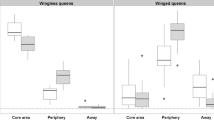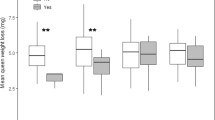Abstract
Evolution of reproduction strategies is affected by both phylogenetic and physiological constraints. Although clonality may benefit females, it may not be selected if a male contribution is necessary to start egg laying and embryo development. In little fire ant, Wasmannia auropunctata, sexual populations employ a typical Hymenopteran system of reproduction. In clonal populations, however, queens and males are produced with only maternal and paternal genomes, respectively, whereas sterile workers are produced sexually. Although this system requires both sexes for worker production, previous work has shown that workers may also be produced clonally by the queens. If so, why are males maintained in this species? Our data suggest that fertilization is necessary to increase the hatching rate of eggs. Although clonal queens can indeed produce both workers and queens without mating, the hatching rate is far below the level necessary to maintain functional colonies. On the other hand, virgin queens from populations exhibiting the original Hymenopteran reproduction system also show low hatching rates, but produce only haploid male eggs. Reasons for the existence of W. auropunctata males have been disputed. However, our data suggest that physiological constraints, such as the requirement for insemination, must be considered in regard to evolution of reproduction systems, in addition to ecological data and theoretical considerations of fitness.


Similar content being viewed by others
References
Avila FW, Sirot LK, LaFlamme BA, Rubinstein CD, Wolfner MF (2011) Insect seminal fluid proteins: identification and function. Annu Rev Entomol 56:21–40
Baer B, Heazlewood JL, Taylor NL, Eubel H, Millar AH (2009) The seminal fluid proteome of the honeybee Apis mellifera. Proteomics 9:2085–2097
Beukeboom L, Vrijenhoek R (1998) Evolutionary genetics and ecology of sperm-dependent parthenogenesis. J Evol Biol 11:755–782
Bourke AFG (1988) Worker reproduction in the higher eusocial Hymenoptera. Q Rev Biol 63:291–311
Chen PS (1996) The accessory gland proteins in male Drosophila: structural, reproductive and evolutionary aspects. Experientia 52:503–510
Choe JC (1988) Worker reproduction and social evolution in ants (Hymenoptera: Formicidae). In: Trager JC (ed) Advances in Myrmecology. E. J. Brill, Leiden, pp 163–187
Collins AM, Caperna TJ, Williams V, Garrett WM, Evans JD (2006) Proteomic analyses of male contributions to honey bee sperm storage and mating. Insect Mol Biol 15:541–549
Fletcher DJC, Ross KG (1985) Regulation of reproduction in eusocial Hymenoptera. Ann Rev Entomol 30:319–343
Foucaud J, Jourdan H, Le Breton J, Loiseau A, Konghouleux D, Estoup A (2006) Rare sexual reproduction events in the clonal reproduction system of introduced populations of the little fire ant. Evolution 60:1646–1657
Foucaud J, Fournier D, Orivel J, Delabie JHC, Loiseau A, Breton JL, Kergoat GJ, Estoup A (2007) Sex and clonality in the little fire ant. Mol Biol Evol 24:2465–2473
Foucaud J, Estoup A, Loiseau A, Rey O, Orivel J (2010a) Thelytokous parthenogenesis, male clonality and genetic caste determination in the little fire ant: new evidence and insights from the lab. Heredity 105:205–212
Foucaud J, Orivel J, Loiseau A, Delabie JHC, Gerber B, Jourdan H, Vonshak M, Tindo M, Mercier JL, Mikissa JB, McGlynn T, Thompson T, Mikheyev AS, Oettler J, Estoup A (2010b) Worldwide invasion by the little fire ant: routes of introduction and eco-evolutionary pathways. Evol Appl 3:363–374
Fournier D, Estoup A, Orivel J, Foucaud J, Jourdan H, Breton JL, Keller L (2005a) Clonal reproduction by males and females in the little fire ant. Nature 435:1230–1234
Fournier D, Foucaud J, Loiseau A, Cros-Arteil S, Jourdan H, Orivel J, Le Breton J, Chazeau J, Dejean A, Keller L, Estoup A (2005b) Characterization and PCR multiplexing of polymorphic microsatellite loci for the invasive ant Wasmannia auropunctata. Mol Ecol Notes 5:239–242
Heifetz Y, Lung O, Frongillo EA Jr, Wolfner MF (2000) The Drosophila seminal fluid protein Acp26Aa stimulates release of oocytes by the ovary. Curr Biol 10(2):99–102
Hughes WHO, Boomsma JJ (2004) Genetic diversity and disease resistance in leaf-cutting ant societies. Evolution 58:1251–1260
Hughes WOH, Oldroyd BP, Beekman M, Ratnieks FLW (2008) Ancestral monogamy shows kin selection is key to the evolution of eusociality. Science 320:1213–1216
Hulce D, Li X, Snyder-Leiby T (2011) GeneMarker® genotyping software: tools to increase the statistical power of DNA fragment analysis. J Biomol Tech 22:35–36
Khila A, Abouheif E (2008) Reproductive constraint is a developmental mechanism that maintains social harmony in advanced ant societies. Proc Natl Acad Sci U S A 105:17884–17889
Khila A, Abouheif E (2010) Evaluating the role of reproductive constraints in ant social evolution. Phil Trans R Soc B 365:617–630
Kjar DS, Suman TW (2007) First records of invasion by the myrmicine Japanese ant Vollenhovia emeryi WM Wheeler (Hymenoptera: Formicidae) in the United States. Proc Entomol Soc Wash 109:596–604
Kobayashi K, Hasegawa E, Ohkawara K (2008) Clonal reproduction by males of the ant Vollenhovia emeryi (Wheeler). Entomol Sci 11:167–172
Kubli E (2003) Sex-peptides: seminal peptides of the Drosophila male. Cell Mol Life Sci 60:1689–1704
Lehmann R, Nüsslein-Volhard C (1991) The maternal gene nanos has a central role in posterior pattern formation of the Drosophila embryo. Development 112:679–691
Lehtonen J, Schmidt DJ, Heubel K, Kokko H (2013) Evolutionary and ecological implications of sexual parasitism. Trends Ecol Evol 28:297–306
Masui Y (1985) Meiotic arrest in animal oocytes. In: Metz CB, Monroy A (eds) Biology of fertilization, 1st edn. Academic, Florida, pp 189–219
Matsuura K, Vargo EL, Kawatsu K, Labadie PE, Nakano H, Yashiro T, Tsuji K (2009) Queen succession through asexual reproduction in termites. Science 323:1687–1687
Maynard SJ (1978) The evolution of sex. Cambridge University Press, Cambridge
Mikheyev AS, Bresson S, Conant P (2009) Single-queen introductions characterize regional and local invasions by the facultatively clonal little fire ant Wasmannia auropunctata. Mol Ecol 14:2937–2944
Okamoto M, Ohkawara K (2010) Egg production and caste allocation in the clonally reproductive ant Vollenhovia emeryi. Behav Ecol 21(5):1005–1010
Page AW, Orr-Weaver TL (1997) Activation of the meiotic divisions in Drosophila oocytes. Dev Biol 183:195–207
Pearcy M, Aron S, Doums C, Keller L (2004) Conditional use of sex and parthenogenesis for worker and queen production in ants. Science 306:1780–1783
Pearcy M, Goodisman MAD, Keller L (2011) Sib mating without inbreeding in the longhorn crazy ant. Proc R Soc B 278:2677–2681
Perez-Staples D, Aluja M, Macias-Ordonez R, Sivinski J (2008) Reproductive trade-offs from mating with a successful male: the case of the tephritid fly Anastrepha obliqua. Behav Ecol Sociobiol 62:1333–1340
Reber A, Castella G, Christe P, Chapuisat M (2008) Experimentally increased group diversity improves disease resistance in an ant species. Ecol Lett 11:682–689
Rey O, Loiseau A, Facon B, Foucaud J, Orivel J, Cornuet JM, Robert S, Dobigny G, Delabie JHC, Mariano CDSF, Estoup A (2011) Meiotic recombination dramatically decreased in thelytokous queens of the little fire ant and their sexually produced workers. Mol Biol Evol 28:2591–2601
Rey O, Facon B, Foucaud J, Loiseau A, Estoup A (2013) Androgenesis is a maternal trait in the invasive ant Wasmannia auropunctata. Proc R Soc B 280:20131181
Schrempf A, Heinze J, Cremer S (2005) Sexual cooperation: mating increases longevity in ant queens. Curr Biol 15:267–270
Seeley TD, Tarpy DR (2007) Queen promiscuity lowers disease within honeybee colonies. Proc Roy Soc Lond B 274:67–72
Styhler S, Nakamura A, Swan A, Suter B, Lasko P (1998) vasa is required for GURKEN accumulation in the oocyte, and is involved in oocyte differentiation and germline cyst development. Development 125:1569–1578
Tarpy DR, Seeley TD (2006) Lower disease infections in honeybee (Apis mellifera) colonies headed by polyandrous vs monandrous queens. Naturwissenschaften 93:195–199
Tautz D, Pfeifle LC (1989) A non-radioactive in situ hybridization method for the localization of specific RNAs in Drosophila embryos reveals translational control of the segmentation gene hunchback. Chromosoma 98:81–85
Vargo EL, Porter SD (1993) Reproduction by virgin queen fire ants in queenless colonies: comparative study of three taxa (Solenopsis richteri, hybrid S. Invicta/richteri, S. Geminata) (Hymenoptera: Formicidae). Insect Soc 40:283–293
Vargo EL, Labadie PE, Matsuura K (2012) Asexual queen succession in the subterranean termite Reticulitermes virginicus. Proc R Soc B 279:813–819
Williams GC (1975) Sex and evolution. Princeton University Press, Princeton
Wolfner MF (1997) Tokens of love: functions and regulation of Drosophila male accessory gland products. Insect Biochem Mol Biol 27:179–192
Yamamoto DS, Tachibana K, Sumitani M, Lee JM, Hatakeyama M (2008) Involvement of Mos–MEK–MAPK pathway in cytostatic factor (CSF) arrest in eggs of the parthenogenetic insect, Athalia rosae. Mech Dev 125:996–1008
Acknowledgments
We thank Ms. T. Vo, Dr. C. Vanderwoude, and Ms. M Montgomery for the help with field collections. In addition, we thank Prof. T. Miura, Dr. K. Ogawa, Dr. Hi. Miyakawa, and Dr. Mochizuki whose work helped us with embryo staining and confocal microscopy. We especially thank Dr. Steven D. Aird for the editing of our manuscript. This study was supported by a Japan Society for the Promotion of Science (JSPS) Research Fellowship for young scientists (MO) and also by funding from Okinawa Institute of Science and Technology Graduate University (OIST) and a JSPS Kakenhi grant (13058556, to ASM).
Author information
Authors and Affiliations
Corresponding author
Additional information
Communicated by: Sven Thatje
Rights and permissions
About this article
Cite this article
Miyakawa, M.O., Mikheyev, A.S. Males are here to stay: fertilization enhances viable egg production by clonal queens of the little fire ant (Wasmannia auropunctata). Sci Nat 102, 15 (2015). https://doi.org/10.1007/s00114-015-1265-8
Received:
Revised:
Accepted:
Published:
DOI: https://doi.org/10.1007/s00114-015-1265-8




